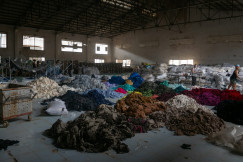Library
02 June 2025
The Netherlands’ 2025-2030 circular textile policy charts a path toward full circularity
Library
02 June 2025
Ecosystem's readiness to support EU strategic autonomy and defence efforts
R&I, techniques and technological solutions
Social dimension
+15 more
Login / create an account to be able to react
-
7

The Netherlands’ 2025-2030 policy programme sets out a bold framework to cut textile waste, enforce sustainability targets, and boost reuse and recycling, laying the foundation for a fully circular textile sector by 2050.
Topics
Netherlands
Academic / Research and VET Institutions
Company with 250 or more employees
Cultural and Heritage Organisations
Destination Management & Marketing Organisations
EU Institutions
Financial Institutions and Investors
International Organisations
Local Authorities
National authorities
NGOs / Non-profits
Regional Authorities
SMEs (a company with less than 250 employees)
Social Economy Entity
-
Transition Pathway's building blocks
-
-
Ecosystem's readiness to support EU strategic autonomy and defence efforts
-
R&I, techniques and technological solutions
-
Social dimension
-
Sustainable competitiveness
-
Regulation and public governance
-
-
Industrial ecosystems
-
-
Proximity and social economy
-
Textile
-
-
Textiles ecosystem areas
-
-
Fibres, yarns and fabrics
-
Apparel and clothing accessories
-
Household/interior textiles
-
Technical textiles
-
Leather and fur
-
Footwear
-
Research and Innovation
-
Technology and Machinery
-
Waste management, reuse and repair
-
Business support and Communication
-
Not area specific (interested in more than one of the above)
-
Share
The Dutch government has released its second circular textile policy programme for 2025-2030, aiming to build a fully circular textile value chain by 2050. Part of the National Circular Economy Programme, the plan focuses on cutting raw material use, increasing sustainability, reducing textile waste, and encouraging longer product lifespans through national and EU-aligned measures.
Key Takeaways:
- Strategic pillars: The policy centres on four pillars, reducing raw material input, substituting with sustainable materials, extending product life, and promoting high-quality reuse and recycling.
- Reduction in consumption: Aims to lower average annual clothing purchases from 50 to 35 items per person by 2030.
- Mandatory sustainability targets: At least 50% of textile content must be sustainable by 2030, supported by the development of a robust definition of ‘sustainable textile.’
- Reuse and recycling: Aims to significantly increase reuse and mechanical fibre-to-fibre recycling through innovation, regulation, and sector collaboration.
- Producer responsibility: Builds on the Extended Producer Responsibility (EPR) framework to prevent overproduction, encourage reuse, and improve collection and sorting systems.
- Product destruction ban: Legislative efforts will target a ban on the destruction of unsold textiles.
- Digital product passport: The Netherlands will support the introduction of digital product passports to improve traceability and material data transparency.
- Monitoring and governance: Progress will be evaluated through regular stakeholder dialogues and annual reports to Parliament, with clear roles assigned to national and regional bodies.
This forward-looking policy positions the Netherlands as a European leader in textile circularity, with ambitious yet actionable goals designed to reshape the sector by 2050.
To explore the full strategy, you can access the official report here.
Comments (0)
See also
-
40
Transition Pathway for a resilient, sustainable, and digital textiles ecosystem
- Categories
- Infrastructure Investments and funding R&I, techniques and technological solutions +28 more
-
80
The EU’s vision for sustainable fashion: transforming the textiles sector by 2030
- Categories
- Infrastructure Investments and funding R&I, techniques and technological solutions +28 more
-
9
Cross-industry and sectoral social dialogue
- Categories
- Infrastructure Investments and funding R&I, techniques and technological solutions +28 more




